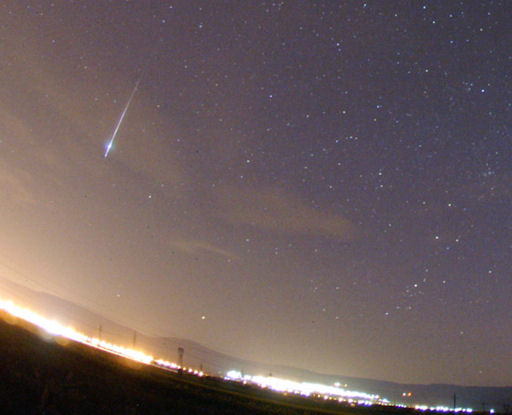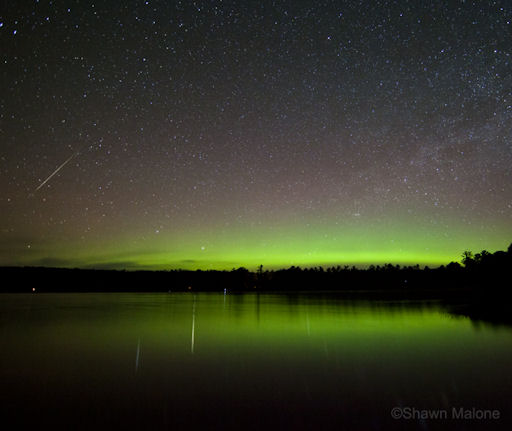Metallic photos of the sun by renowned photographer Greg Piepol bring together the best of art and science. Buy one or a whole set. They make a stellar gift. | | |
LOW SUNSET CONJUNCTION: If you have a clear view of the western horizon, look there tonight, Sunday April 22nd, just after the sun goes down. Jupiter is shining close to an exquisitely-thin crescent Moon. It's a nice photo-op. images: #1, #2, #3, #4.
METEOR SHOWER RECAP: According to the International Meteor Organization, the Lyrid meteor shower peaked on April 22nd around 0000 UT with a maximum between 20 and 30 meteors per hour. This doesn't place the Lyrids among the year's best showers, but many observers were pleasantly surprised. "This year's Lyrid shower was much better than I expected! I saw dozens of meteors, mostly Lyrids, nice and quick ones," reports Monika Landy-Gyebnar, who caught this Lyrid over the glow of her hometown Veszprem, Hungary:

The meteors were serenaded by nightingales. "The birds arrived here about a week ago and they were constantly singing, which made the observation even more memorable!" she adds. "Imagine being out at night, surrounded by nightingales, with a bright Milky Way and meteors falling through our atmosphere - a wonderful celebration of Earth Day in 2012 which coincided with the Lyrid maximum!"
more images: from Pete Lawrence of Selsey, West Sussex, UK; from Shawn Malone near Marquette, Michigan; from Jimmy Westlake of Stagecoach, Colorado; from Darren Baskill of East Sussex, UK; from Brian Emfinger of Ozark, Arkansas; from Ivan Majchrovic of Marianka, Slovakia; from Peter Meadows of Chelmsford, Essex, UK; from Ireneusz Nowak of Wroclaw, Poland; from Michael Noble of Alberta, Canada;
AURORA BOREALIS: Northern sky watchers on the lookout for meteors this weekend were surprised, in many places, by a display of auroras. "Northern Lights were visible most the night as a persistent glowing arc low on the horizon," reports Shawn Malone of Marquette, Michigan. "I spent a clear moonless night on the shore of Lake Superior and saw some nice Lyrid meteors cutting through the auroras."

The auroras was caused by the interplanetary magnetic field (IMF), which tipped south and opened a crack in Earth's magnetosphere. Solar wind poured in to fuel the display. A minor CME might have also swept past Earth during the early hours of Aprill 22nd, further amplifying the lights. Aurora alerts: text, voice.
For the record, Lyrid meteors disintegrate in Earth's atmosphere a little lower than most auroras, so the two phenomena do not entirely overlap. Visually, if not physically, however, it was a beautiful coincidence. Browse the links for more examples: from Yuichi Takasaka of Lumby, British Columbia, Canada; from Mark Nolan of Culdaff Beach, Ireland.

